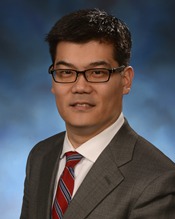Program Information
Feasibility Studies of the Use of An Averaged HU-To-SPR Calibration Curve of Multiple CT Scanners for Dose Calculations in Proton Radiotherapy
H Chung*, A Gopal , G Lasio , H Xu , S Mossahebi , J Polf , University of Maryland School of Medicine, Baltimore, MD
Presentations
SU-I-GPD-T-204 (Sunday, July 30, 2017) 3:00 PM - 6:00 PM Room: Exhibit Hall
Purpose: Purpose is to quantify the variability of the stoichiometric calibration for different CT scanners for proton radiotherapy and determine if an averaged HU-to-SPR calibration curve can be used across all the CT scanners.
Methods: HU-to-SPR calibration curves were generated using CIRS CT phantom on 5 CT scanners. A separate HU-to-SPR curve was generated for each CT scanner and one averaged of all 5 individual CT curves. Next, a set of surrogate tissue samples were scanned, loaded into a treatment planning system (TPS), and the water equivalent thickness (WET) of each sample was calculated using the 5 CT and averaged HU-to-SPR calibration curves. The surrogate tissues were irradiated with a proton beam to measure WET. The individual scanner and averaged HU-to-SPR curves were adjusted to optimize agreement between the measured and the TPS calculated WET values. After the adjustment, a separate set of tissue samples were CT scanned and WET calculated with the TPS (using the optimized curves) and measured to evaluate the overall uncertainty of the optimized individual CT and averaged HU-to-SPR calibration curves.
Results: The largest percent difference between the TPS calculated and measured WET values for the tissue samples was 7.4% (femur) for CT specific calibration curves and 7.2% (femur) for the averaged calibration curve prior to optimization of the curves. WET percent difference for the optimized calibration curves ranged from 4.4% (heart) for the CT specific calibration curves to 1.5% (tissue) for the average curve. The overall mean uncertainty was 1.7% (2σ = 2.4%) for averaged calibration curve and 1.8% (2σ = 2.3%) for the 5 CT scanners.
Conclusion: Using the optimized averaged HU-to-SPR calibration curve showed lower overall uncertainty when compared against 5 CT scanners. It is possible to reduce the calibration uncertainty to 2% by optimizing the curve using a tissue sample study.
Contact Email:
